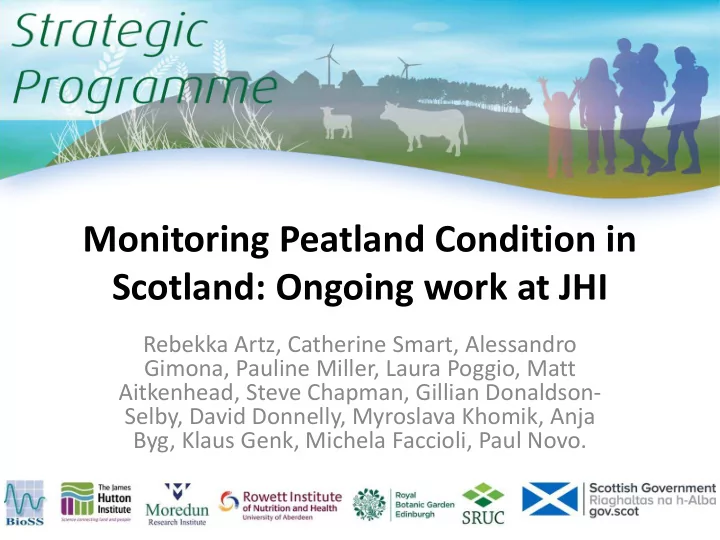

Monitoring Peatland Condition in Scotland: Ongoing work at JHI Rebekka Artz, Catherine Smart, Alessandro Gimona, Pauline Miller, Laura Poggio, Matt Aitkenhead, Steve Chapman, Gillian Donaldson- Selby, David Donnelly, Myroslava Khomik, Anja Byg, Klaus Genk, Michela Faccioli, Paul Novo.
Several ongoing projects Monitoring of the RSPB Forsinard restoration success and assessing influence of drought – vegetation, GHG, peat depths, soil organic matter composition and fungal community) – 2016-21* 1. Soil C stocks assessments in peatlands (2016-21) 2. a) Effectiveness of a MODIS-based model in estimating peatland condition (2016-18) and b) Predictive modelling of restoration management impacts on peatland habitat composition – covers large and fine scale aspects (2016-21) 3. Peatlands: Remote sensing approaches to detect drainage features in peatlands (phase 2, 2016-17 ClimateXchange) 4. Monetary and non-monetary values of peatland ecosystem services
Our peat soil maps are still not good enough at local level Table 4. Condensed error matrix for the validation of the slope-limited peat basemap for Scotland, using the 3185 points in the 5 km National Soil Inventory of Scotland (NSIS) data, and comparison with earlier basemaps. Peat in NSIS Peat soil in NSIS Not peat in NSIS 20% slope limited Hutton & BGS unified basemap Modelled to be peat 560/728 = 77% 534/2457 = 21.7% Hutton & BGS unified basemap Modelled to be peat 362/728 = 50% 660/2457 = 26.9% 1:250,000 Hutton basemap Modelled to be peat 225/728 = 30% 633/2457 = 25.8 %
Effectiveness of a MODIS-based model in estimating peatland condition CSM Site MODIS DEM Condition Time series Modelling 100m resolution ~ 7 million cells
Elevation Tested covariates EVI NDWI Snow Primary productivity • Land Surface Temperature • Interpolated % organic matter in soil •
Probability of cells containing peatland in unfavourable condition Spatial distribution not yet • constrained to ‘true peats’ as there is no such dataset, however data ‘make sense’ when checked against known areas of erosion, forestry, peat cutting, burning etc
Predictive modelling Effects of large scale peatland restoration efforts – using known restoration sites (dataset currently being assembled from various sources including SNH Peatland Action sites) and projected scenarios (tripling of effort, targeting specific current land cover categories) long-term climate change projections (with help of PhD student Kirsten Lees @ Reading)
Predictive modelling (site scale) Modelling changes in spatial distribution of peatland species (e.g. vegetation) in response to restoration management activities Uses existing 2013 UAV and new 2016/17 Lidar/UAV high resolution aerial imagery for Forsinard restoration chronosequence and newly acquired data to build model of trajectory of changes
Aerial images acquired (August 2013) Drained Talaheel (1998) Catanach (2003-04) Altandubh Leir (2004-05) (2005-06) Forestry Baird control (2002-03) Sleach Drain (2006-07) blocked Cross Lochs (Near natural) Eddy flux towers
Forsinard forest-to-bog restoration: UAV data Altandubh (2004-2005) Talaheel (restored 1998) Cross Lochs (intact)
Drainage mapping Phase 1 report online at CxC A total of 338 sites were selected on peat soils across Scotland, and classified as to whether they contained artificial drainage in a 500 x 500m block at each site. Of these, 93 had some level of artificial drainage (27.5%), with 45 being estimated as fully drained within the 500m block.
Drainage mapping using EO data - Phase 2 is a more inclusive approach to cover all potential peatland areas - Uses a new model of peat soil distribution (checked against NSIS and superior to older maps) and LCS88 Area % # of points Class 0 (onlyLCS88) 0.39 102 Class 1 (<=30% peat) 0.06 67 Class 2 (>30, <=50% peat) 0.34 149 Class 3 (>50, <100% peat) 0.02 22 Class 4 (100% peat) 0.19 160
Monetary and non-monetary values of peatland ecosystem services • Preferences for peatland restoration (stated preference survey w. general public) • Cost effectiveness of different restoration options (analysis of data on existing restoration projects) • Perceived benefits & dis-benefits from peatland restoration (Interviews & focus groups with land managers, restoration volunteers & local residents)
Thank you! Contacts: - Digital soil mapping: Steve Chapman, Allan Lilly - Greenhouse gas monitoring: Myroslava Khomik - Remote sensing and modelling: Rebekka Artz, Laura Poggio, Matt Aitkenhead - Peatland restoration valuation : Klaus Genk, Anja Byg, Paula Novo, Michela Faccioli and Carol Kyle
Recommend
More recommend